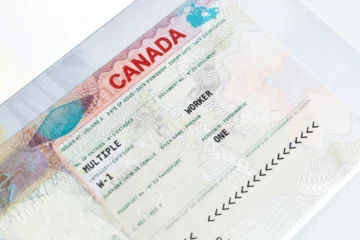This article covers a few of the most common questions about LMIA-based and LMIA-exempt Work Permits.
Canada issues hundreds of thousands of work permits each year to talented individuals around the world. To support its economic and social objectives Canada opens its doors to foreign workers, with the opportunity to immigrate and become Canadian citizens.
Table of contents
- Does What I Plan to do Qualify as Work?
- What is LMIA?
- Obtaining a Canadian Work Permit Under the LWIA
- What is the International Mobility Program (IMP)?
- Obtaining a Canadian work permit under the International Mobility Program?
- How do Government Officers Issue a Work Permit to a Foreign National Without LMIA?
Does What I Plan to do Qualify as Work?
If you’re visiting family in Canada as a foreign national, but have brought your laptop along to get some work done while visiting; if you’re working remotely for a company or clients in your home country, it is not competition for the Canadian Labour Market. You are not considered to be working in Canada. If you do some volunteer work in Canada, if there are no wages involved, that is not considered work.
If you’re visiting family in Canada, and all your needs are being taken care of by your family; if you help out by making repairs around the place, or by working on the farm during the harvest as an equitable exchange, you are not considered to be working in Canada. Again, this is because there are no wages involved. Providing service in exchange for room and board while visiting, or for clothing or products, falls under the same category.
A work permit or authorization to work without a permit is required for a foreign national to be allowed to work in Canada under the Temporary Foreign Worker Program or the International Mobility Program (IMP).
What is LMIA?
Employers must obtain a Labour Market Impact Assessment (LMIA) before hiring foreign workers to fill temporary labour and skill shortages. The LMIA verifies that there is a need for a temporary worker and that no Canadians or permanent residents are available to do the particular job. The purpose of the LMIA is to confirm that foreign workers are not being chosen over Canadian citizens and/or permanent residents who are qualified to do the job.
Getting an LMIA based work permit is a two-step application process. The first step is applying for an LMIA to Service Canada. The second step is to apply for a work permit once your prospective employer has obtained a positive LMIA from Service Canada. A work permit application is submitted to Immigration, Refugees and Citizenship Canada (IRCC).
Obtaining a Canadian Work Permit Under the LWIA
An Employment Offer is an official letter from the Canadian employer, which confirms that an employment position has been offered to you. This letter states your name, position or occupation with the company, your pay rate and any deductions, your duties and the hours of the week or month you will work.
In the first step of the LMIA work permit application, you will obtain a copy of the employer’s approved LMIA. The employer must submit your name to ESDC to assign the LMIA position specifically to you.
In the second step, you will prepare your LMIA work permit application. The LMIA Work Permit Application consists of application forms, supporting documents and the applicable processing fees.
Skilled Work Permits
Skilled work permits are obtained in an occupation under the National Occupational Classification (NOC), based upon skill levels 0, A or B. For skilled work permits, applicants typically need to have 1 to 3 years of experience. Proof of English CLB 7 or French NCLC7 language skills may be essential to meet certain job requirements, but the skills needed will depend on the group the job is classified in under the National Occupational Classification system (NOC).
Semi-Skilled work permits
Semi-Skilled work permits are obtained in an occupation under the National Occupational Classification (NOC), based upon skill levels C & D. Semi-Skilled work permits require a minimum of high school education or job-specific training. Proof of English CLB 7 or French NCLC7 language skills may also be essential to meet certain job requirements.
High-Wage Workers
Employers who are offering a wage that is at or above the provincial/territorial median hourly wage should file an LMIA application under the high-wage stream. These employers must submit transition plans with their LMIA application to affirm that they are taking steps to reduce their reliance on temporary foreign workers over time.
A transition plan is designed to ensure that employers seeking foreign workers are fulfilling the purpose of the program; using it as a last and limited resort to address immediate labour needs on a temporary basis, when qualified Canadians are not available. The transition plan outlines the activities the employer is agreeing to undertake to recruit, train and retain Canadians and permanent residents, to reduce reliance on the Temporary Foreign Worker Program.
Low-Wage Workers
An employer is required to submit an LMIA application under low-wage occupation if the wages offered to foreign nationals is below that of the provincial/territorial median hourly wage. In this instance, the employer does not need to submit a transition plan with the LMIA application. To restrict access to the Temporary Foreign Worker Program (TFWP), the Canadian Government has put a cap in place to limit the number of low-wage temporary workers the business can employ.
The cap does not apply if the employer is hiring temporary foreign workers for on-farm agricultural positions, paying for round-trip transportation, providing affordable housing, paying for private health insurance and registering each temporary foreign worker (TFW) with the provincial/territorial workplace safety board. An employer-employee contract must be submitted.
What is the International Mobility Program (IMP)?
The IMP lets employers hire temporary workers without a Labour Market Impact Assessment (LMIA). These exemptions from the usual LMIA process may be based upon broader economic, cultural and competitive advantages, or perceived reciprocal benefits to be enjoyed by Canadians and permanent residents.
The International Mobility Program (IMP) is one of the common pathways for working in Canada. Foreign workers who meet the eligibility requirements under the IMP can apply to IRCC to obtain a work permit. Canada encourages residents, such as international graduates, and their eligible spouses or partners to obtain work permits under the IMP, so they can gain local work experience while supporting themselves financially during the time they live in the country.
Obtaining a Canadian work permit under the International Mobility Program?
Obtaining a work permit under the IMP can be led by the foreign worker or the employer. In most cases, the prospective employer pays the employer compliance fee of $230.00 and submits an offer of employment through the Employer Portal. If there’s an employee vacancy at the employer, and the foreign worker is eligible under one of the IMP streams, the employer can then hire the worker.
Common reasons for IMP eligibility include facilitated processing when applying in conjunction with The Canada-United States-Mexico Agreement (CUSMA). Intra-Company Transfers allow qualifying employers to transfer workers to their offices in Canada. Canada also welcomes entertainment industry workers to support its television and film industry.
Foreign business visitors who demonstrate they meet certain criteria, such as a stay of under six months, and refraining from entering the Canadian labour market, could be eligible to work in Canada without needing a work permit. Canada also has bilateral agreements with over thirty countries that allow youth to gain work experience in Canada.
Eligible skilled worker candidates living in Canada can apply for a Bridging Open Work Permit (BOWP) while their permanent residence application is being processed, including eligible spouses/partners of Canadian citizens/permanent residents.
The Post-Graduation Work Permit (PGWP) is the most common work permit under the IMP. Eligible foreign national graduates of Canadian designated learning institutions (DLIs) can obtain a PGWP for up to three years.
How do Government Officers Issue a Work Permit to a Foreign National Without LMIA?
When applying, the foreign national’s proposed benefit to Canada, through the work they do, must be deemed important or notable. The officers reviewing these cases rely on the testimony of credible and distinguished experts in the foreign national’s field, in addition to the objective evidence provided.
The foreign national’s record plays an important role in determining his or her level of achievement. This evidence typically includes an official academic record showing the degree earned from a designated college or university, and any awards or outstanding scholarly achievements. Evidence of significant full-time experience in the occupation in which he or she is sought, submitted by current or past employers – generally ten or more years – is also an important consideration; as are achievements, patents, scholarly contributions and more.
Resources
LMIA-exempt job offers – skilled immigrants (Express Entry)
How can I extend my stay as a worker?
Principles for assisting applicants
How to make a request under the Access to Information Act
How to make a request under the Privacy Act
Labour Market Impact Assessment (LMIA) exemption codes – International Mobility Program
Hire a worker without an LMIA: About the process
Hire a worker without an LMIA: How to hire a temporary worker
Hire a worker without an LMIA: after you hire a temporary worker


2 Comments
Gyula orgon · 02/05/2024 at 4:03 pm
Festès burkolàs kartonozas vàlalunk aki tud segitsen hoszu tàvu munkat keresunk
Dr. Samin Mortazavi · 02/05/2024 at 4:37 pm
Üdvözlöm, beszélned kell a munkaügyi központokkal, az álláskeresés nem tartozik a mi munkaterületünkbe